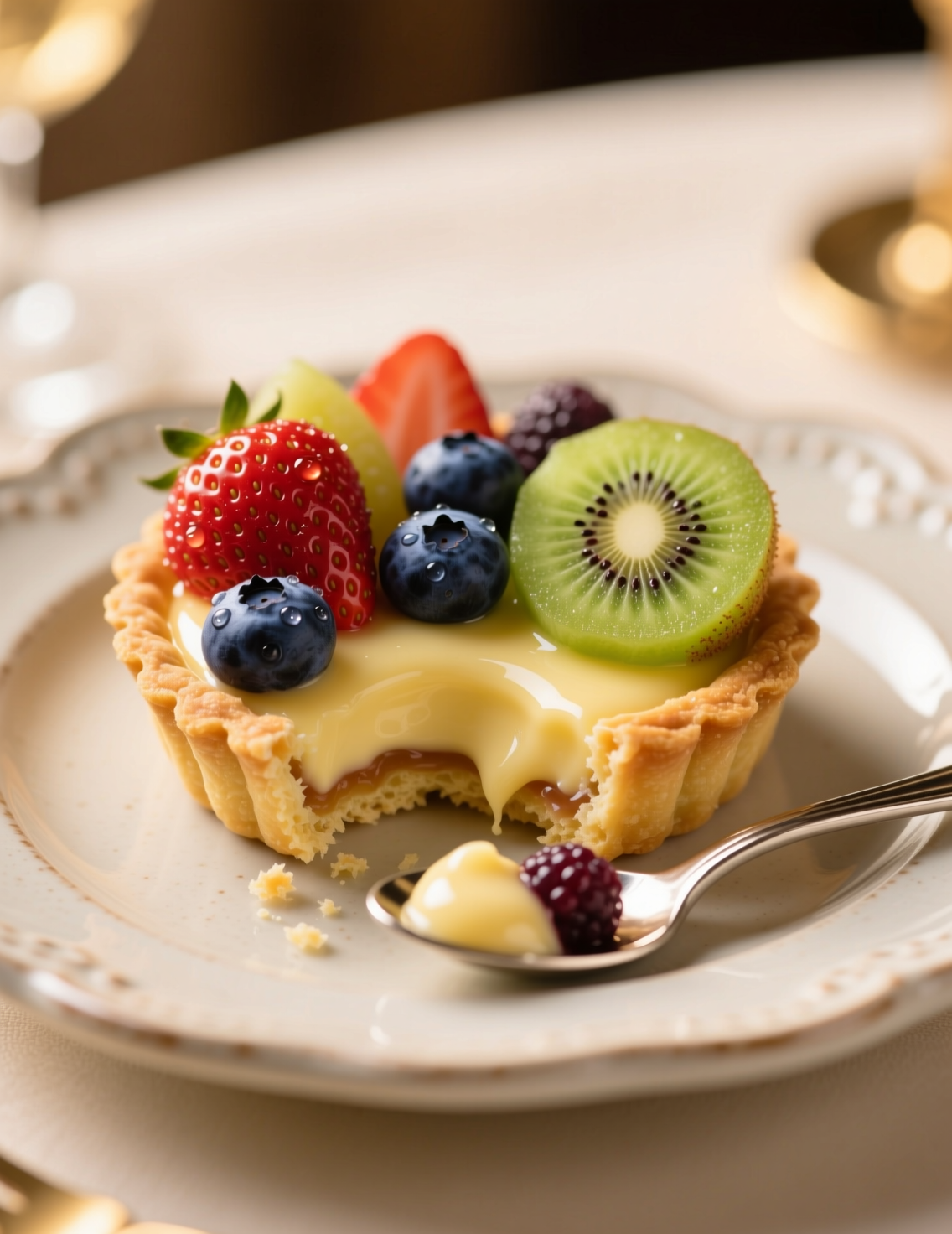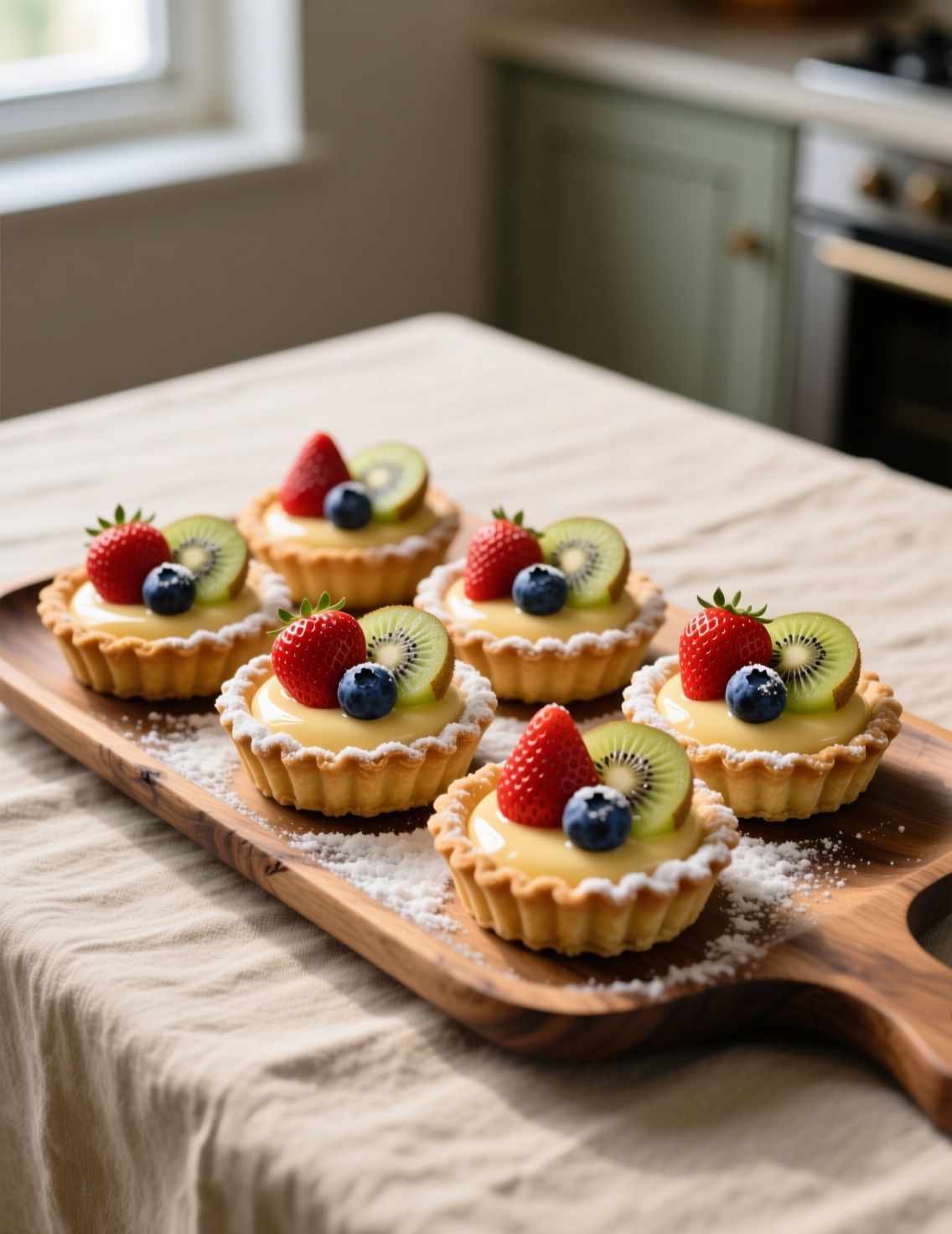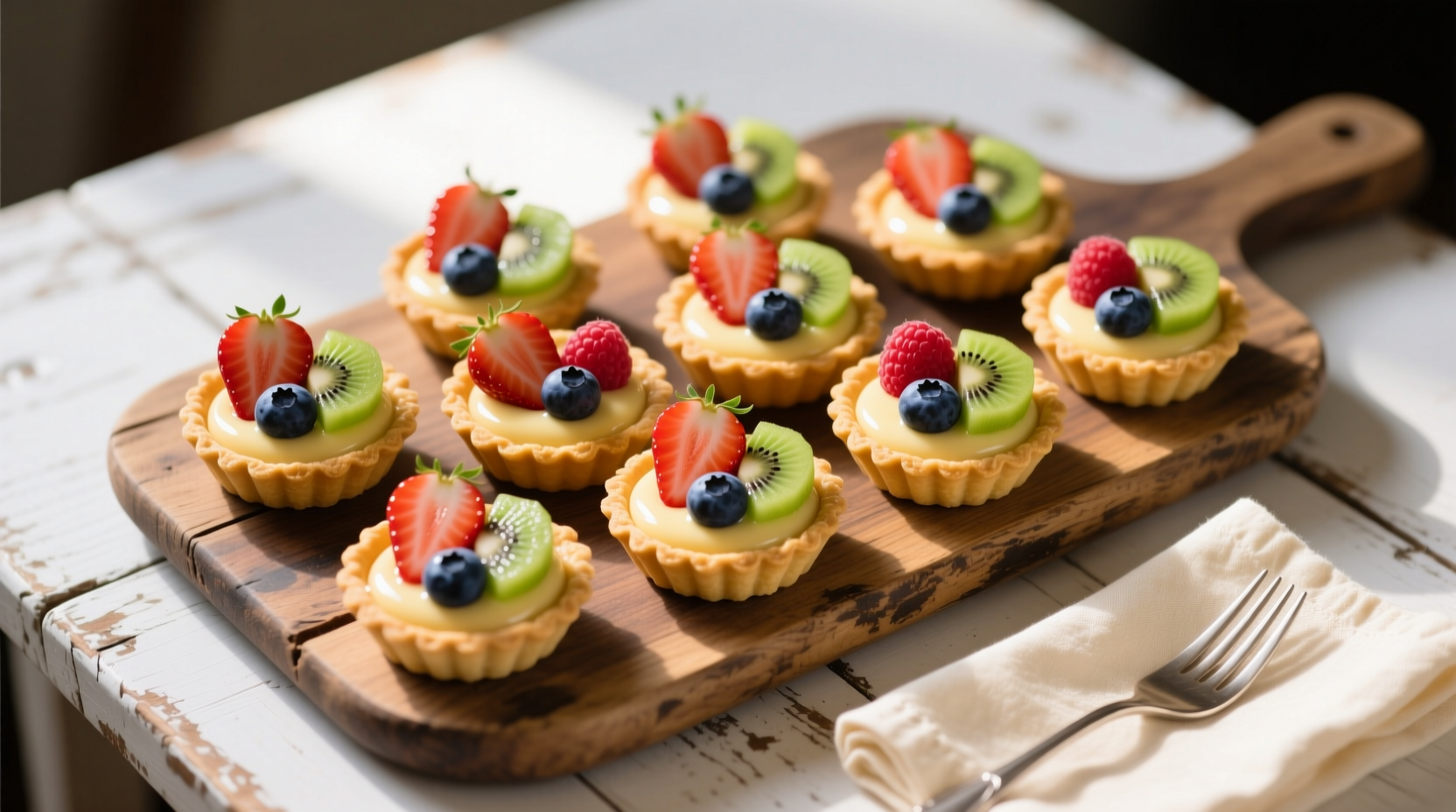Mini fruit tarts are one of those desserts that always feel timeless. They’re small, they’re colorful, and they hit this perfect balance of crisp pastry, smooth filling, and fresh fruit. Professional kitchens treat them as both art and science. They’re delicate enough for a fine dining plated dessert but sturdy enough to survive a catered buffet table. Getting them right, however, is not just about following a recipe—it’s about mastering every step, from dough handling to pastry cream stability to the shine of the glaze.
Why Mini Fruit Tarts Deserve More Respect
Cooks sometimes dismiss fruit tarts as “easy.” A bit of dough, some cream, berries on top—done. But anyone who’s worked pastry stations knows better. The tart shell alone can ruin the day if it shrinks, cracks, or turns soggy. The cream must hold under refrigeration yet not taste like cornstarch paste. And fruit? It’s unpredictable. Berries weep, kiwis brown, stone fruits soften. The point is: making 12 uniform, professional-quality mini tarts is not “easy”—it’s controlled craftsmanship.
Ingredients Breakdown for 12 Servings
The following ratios are scaled specifically for twelve mini tarts. Each tart is about 3 inches across, which is standard in most pastry kitchens.
For the tart shells (pâte sucrée):
- 1 ¾ cups (220 g) all-purpose flour
- ½ cup (65 g) powdered sugar
- ½ teaspoon salt
- ½ cup (115 g) unsalted butter, cold and cubed
- 1 large egg yolk
- 2 tablespoons cold water (as needed)
For the pastry cream:
- 2 cups (500 ml) whole milk
- ½ vanilla bean (or 1 ½ teaspoons pure vanilla extract)
- 5 large egg yolks
- ½ cup (100 g) sugar
- 3 tablespoons (25 g) cornstarch
- 2 tablespoons unsalted butter
For the topping:
- 2 cups mixed fruit (berries, kiwi, mango, peach, grapes—seasonal works best)
- 2 tablespoons apricot jam (for glaze)
- 1 tablespoon water
This structure makes 12 balanced tarts. A professional kitchen may triple or quadruple the recipe for banquets, but this ratio keeps flavors balanced without waste.

Dough Technique: The Silent Discipline
Pâte sucrée is deceptively fragile. Too much mixing, and gluten builds, making shells tough. Too little, and the dough falls apart during lining. Professionals always chill the dough—minimum one hour—before rolling. A lot of students skip that, thinking it’s just about making it “easier to handle.” Not true. Chilling hydrates flour evenly, prevents shrinkage in the oven, and ensures clean edges.
Roll the dough thin, around 2–3 mm, because mini tart shells should not eat like cookies. Docking the dough lightly with a fork prevents puffing, but weights are better. Rice, beans, or professional ceramic beads all work. Blind bake at 350°F (175°C) for 12–14 minutes, then remove weights and bake another 5 minutes until golden. Shells must cool completely before filling. Any warmth will melt pastry cream into soup.
Pastry Cream: Where Science Meets Flavor
Good pastry cream is the difference between a tart that whispers and one that sings. Professionals know it’s about starch gelatinization and egg coagulation, controlled together. Cornstarch thickens at around 95°C, while eggs curdle at 70°C. The trick is to bring the custard just to a simmer, whisking hard, so the cornstarch protects the eggs before they scramble. That’s why pastry chefs temper yolks slowly—hot milk into yolks, never yolks into hot milk.
When done right, cream should be thick enough to pipe yet soft enough to spread. Butter is added off heat for richness and sheen. Some pros whisk in whipped cream for a diplomat-style filling, but for small tarts, pure pastry cream works best. It holds fruit securely and gives a clean bite.
Fruit Selection: More Than Pretty Colors
Mini fruit tarts are judged first by sight. Shiny strawberries, bright kiwi, deep blueberries—they draw the eye. But professionals select fruit not just for color but for structure and shelf-life. Berries are fragile but hold bright acidity. Stone fruits add sweetness but soften after a few hours. Citrus segments are gorgeous but tricky because they leak juice.
The rule: balance aesthetics with practicality. If plating for an event that lasts several hours, sturdier fruits like grapes, kiwi, and mango outperform delicate raspberries. Strawberries, if used, must be fully ripe yet not overly juicy.
The Role of the Glaze
Glaze does more than add shine. It prevents fruit from oxidizing and drying. Apricot jam is classic because it’s neutral and doesn’t overpower flavors. Professionals thin it with water, strain out solids, then brush lightly over fruit. It’s not optional—it’s the barrier between fresh fruit and oxygen. Skip it, and within an hour, your strawberries look tired and your kiwi dull.
Assembly: Professional Standards
Once all components are ready, assembly is quick. Pastry cream is piped into shells with a pastry bag for neatness. Fruit is arranged with intention—odd numbers, varied colors, no overcrowding. Professionals think about “eye movement” across the tart. A tart with three berries looks deliberate; one piled with random fruit looks messy.
After fruit placement, glaze is brushed carefully, not poured. Too much glaze pools and makes shells soggy. The finished tarts should chill briefly (20 minutes) before service to set cream and glaze, but never too long. Fruit loses vibrancy the longer it sits.
Scaling for Catering or Professional Service
Twelve servings is a small batch for a professional kitchen. In catering, production runs may exceed 300 pieces. Efficiency then becomes as important as quality. Dough is often rolled in sheets, cut with cutters, and pressed into tartlet pans by hand or machine. Pastry cream is prepared in large batches, cooled rapidly, and stored under strict refrigeration to prevent bacterial growth.
The fruit arrangement, however, is always done by hand. No machine can replace the trained eye of a pastry chef placing berries at just the right angle. That’s why labor costs for fruit tarts remain high despite simple ingredients.
Nutritional Perspective
One mini tart averages 220–260 calories depending on fruit choice. Pastry cream contributes fat and sugar, while fresh fruit offsets with vitamins, antioxidants, and fiber. Compared to chocolate-heavy desserts, mini fruit tarts feel lighter, though professionals know “lighter” doesn’t always mean low-calorie. What matters is balance. A plated menu might pair one tart with a quenelle of sorbet, offering contrast and reducing portion fatigue.
Common Mistakes Professionals Avoid
- Undercooked pastry cream – leads to a runny mess.
- Warm shells filled too soon – cream melts and never resets.
- Overcrowded fruit – causes uneven glaze and soggy spots.
- Skipping glaze – fruit oxidizes within an hour.
- Overbaked shells – bitterness from browned edges ruins subtle cream flavors.
Each error may look small, but in professional service, details define reputation.
Trends in Mini Fruit Tarts
Modern pastry is shifting toward less sweetness and more natural textures. Instead of polished mirror-glazed fruit, chefs highlight rustic arrangements—fig halves, edible flowers, micro herbs. Some kitchens use coconut pastry cream for dairy-free options. Gluten-free shells are also increasingly common, often made with almond flour, though they require different binding ratios.
Restaurants now serve fruit tarts in tasting menus as a palate cleanser between heavier courses. Bakeries market them as grab-and-go luxury items. The tart’s versatility is its strength—it adapts to trends without losing identity.

Practical Professional Tips
- Always keep tart shells in airtight containers; they stay crisp up to 3 days unfilled.
- Pastry cream should be plastic-wrapped directly on the surface to prevent skin.
- Glazing should be done with a soft pastry brush, never spoons.
- Arrange fruit in radial patterns for speed when plating large batches.
- For flavor depth, brush tart shells with a thin layer of melted chocolate before cream—this also prevents sogginess.
A Word on Timing
Professional pastry chefs work backward. If service is at 7 p.m., shells are baked the day before, cream is cooked early morning, fruit is sliced in the afternoon, and assembly happens just before plating. Timing ensures freshness and efficiency. Home cooks often rush, doing everything same-day, but even small-scale preparation benefits from staging.
Case Study: Event Service
At a wedding I catered last year, we plated 200 mini fruit tarts. The venue had no cooling system, and summer heat threatened disaster. Our workaround: freeze tart shells for 10 minutes before filling to buy time, keep pastry cream in insulated containers, and glaze fruit heavily to protect against dehydration. Not one tart collapsed. The bride later said guests fought over the last few pieces. That’s professional pastry—anticipating failure, building safeguards, and executing anyway.
Conclusion: Crafting 12 Perfect Mini Fruit Tarts
Mini fruit tarts may look simple, but simplicity often hides precision. Every stage—dough, cream, fruit, glaze—demands attention. For 12 servings, it’s manageable, but the same principles scale to 200. Professionals know success isn’t measured only by flavor but by structure, shine, and how long they hold on the buffet table.
If there’s one takeaway, it’s this: respect the details. Chill the dough, temper the cream, choose fruit with intention, glaze with care. Do it right, and mini fruit tarts become more than dessert. They become a statement of craftsmanship, color, and patience on a plate.
FAQs
What is the ideal size for mini fruit tarts?
About 3 inches across is standard in most professional kitchens.
Can I make tart shells ahead of time?
Yes, unfilled shells stay crisp in an airtight container for up to 3 days.
Why does pastry cream sometimes turn runny?
It wasn’t cooked long enough to activate the cornstarch fully.
Do I have to use apricot jam for glaze?
No, but apricot is neutral; other jams may alter color or flavor.
How do I stop tart shells from shrinking?
Chill the dough before baking and use weights during blind bake.
Can mini fruit tarts be frozen?
The shells can, but filled tarts with fruit don’t freeze well.
What fruit works best for topping?
Sturdy fruits like kiwi, grapes, and berries hold shape and color best.
How long can assembled mini fruit tarts sit out?
About 2 hours at room temp, longer if refrigerated properly.
Why do professionals sometimes coat shells with chocolate?
It creates a moisture barrier to prevent soggy bottoms.
Are gluten-free versions possible?
Yes, almond flour or rice flour blends can replace wheat in the shell.

Mariana is a passionate home cook who creates delicious, easy-to-follow recipes for busy people. From energizing breakfasts to satisfying dinners and indulgent desserts, her dishes are designed to fuel both your body and hustle.
When she’s not in the kitchen, she’s exploring new flavors and dreaming up her next recipe to share with the Foodie Hustle community.

